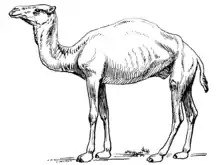Paracamelus
Paracamelus is an extinct genus of camel in the family Camelidae. It originated in North America during the Middle Miocene but crossed the Beringian land bridge into Eurasia during the Late Miocene, approximately 7.5–6.5 Ma; its later range spanned from Spain and Italy to Chad and Shanxi Province, China.[3] It is ancestral to living camels of the genus Camelus. A population remained in northern North America, which became the high Arctic camel, which survived until the Middle Pleistocene approximately 1 Ma.[4]
| Paracamelus | |
|---|---|
 | |
| Scientific classification | |
| Kingdom: | Animalia |
| Phylum: | Chordata |
| Class: | Mammalia |
| Order: | Artiodactyla |
| Family: | Camelidae |
| Tribe: | Camelini |
| Genus: | †Paracamelus Schlosser, 1903[1] |
| Type species | |
| Paracamelus gigas Schlosser, 1903 | |
| Species | |
| |
Taxonomy
Paracamelus was named by Schlosser (1903). Its type is Paracamelus gigas. It was assigned to Camelidae by Carroll (1988).[5]
Fossil distribution
The earliest fossil of Paracamelus is from the Middle Miocene Esmeralda Formation in Nye County Nevada and is between 10–12.5 million years old.[6] After a sea level transgression event, the genus spread to Eurasia arriving in Spain and Italy just prior to the Messinian Salinity Crisis at approximately 6 Ma,[7] before spreading to Africa around the Miocene-Pliocene boundary.[8]
References
- Schlosser, Max (1903). "Die fossilen Säugethiere Chinas nebst einer Odontographie der recenten Antilopen". Abhandlungen der Mathematisch-Physikalischen Klasse der Königlich Bayerischen Akademie der Wissenschaften. 22 (1): 95–97; Pl. 9, Fig. 14, 26
- Logvynenko, V. M. (2001). "Paracamels minor (Camelidae, Tylopoda) — A New Camelid Species from the Middle Pliocene of Ukraine" (PDF). Vestnik Zoologii. 35 (1): 39–42.
- PaleoBiology Database: Paracamelus, basic info
- Rybczynski, Natalia; Gosse, John C.; Richard Harington, C.; Wogelius, Roy A.; Hidy, Alan J.; Buckley, Mike (2013-03-05). "Mid-Pliocene warm-period deposits in the High Arctic yield insight into camel evolution". Nature Communications. 4 (1): 1550. doi:10.1038/ncomms2516. ISSN 2041-1723. PMC 3615376. PMID 23462993.
- R. L. Carroll. 1988. Vertebrate Paleontology and Evolution. W. H. Freeman and Company, New York 1-698
- Stidham, Thomas A.; Zelenkov, Nikita V. (2016). "North American–Asian aquatic bird dispersal in the Miocene: evidence from a new species of diving duck (Anseriformes: Anatidae) from North America (Nevada) with affinities to Mongolian taxa". Alcheringa: An Australasian Journal of Palaeontology. 41 (2): 222–230. doi:10.1080/03115518.2016.1224439. ISSN 0311-5518.
- Colombero, Simone; Bonelli, Edmondo; Pavia, Marco; Repetto, Giovanni; Carnevale, Giorgio (2016). "Paracamelus (Mammalia, Camelidae) remains from the late Messinian of Italy: insights into the last camels of western Europe". Historical Biology. 29 (4): 509–518. doi:10.1080/08912963.2016.1206539. ISSN 0891-2963.
- Likius, Andossa; Brunet, Michel; Geraads, Denis; Vignaud, Patrick (2003). "The oldest Camelidae (Mammalia, Artiodactyla) of Africa : new finds from the Mio-Pliocene boundary, Chad". Bulletin de la Société Géologique de France. 174 (2): 187–193. doi:10.2113/174.2.187. ISSN 0037-9409.
Further reading
- Titov, Vadim V.; Logvynenko, Vitaliy N. (2006). "Early Paracamelus (Mammalia, Tylopoda) in Eastern Europe". Acta Zoologica Cracoviensia. A: Vertebrata. 49 (1–2): 163–178. doi:10.3409/000000006783995544.
- Kostopoulos, Dimitris S.; Sen, Sevket (1999). "Late Pliocene (Villafranchian) mammals from Sarikol Tepe, Ankara, Turkey". Mitteilungen der Bayerischen Staatssammlung für Paläontologie und historische Geologie. 39: 187–192.